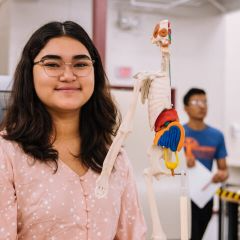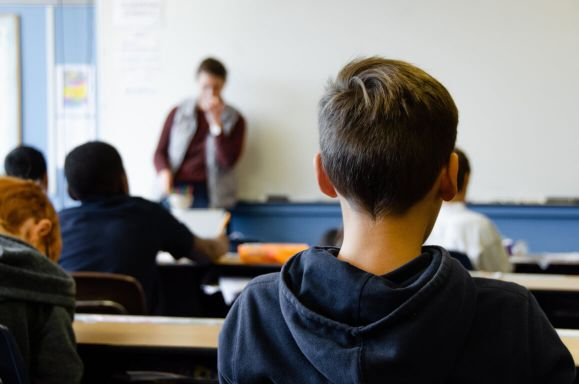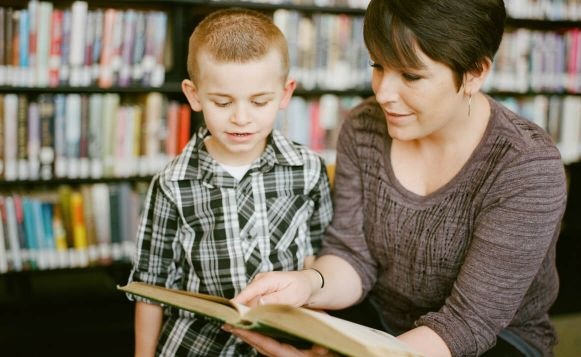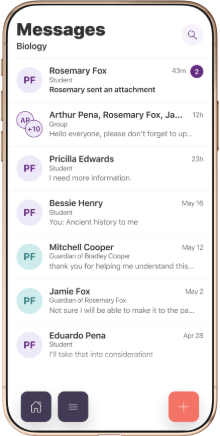Why parent-teacher communication matters
Parent-teacher communication is a chance for parents and educators to collaborate, listen, and share ideas on behalf of the student. When schools prioritize parental engagement, students reap the benefits both in the classroom and at home.
There are waves of evidence that link parental involvement with student success.
Here are a few statistics that may surprise you:
Teacher-family communication increases the odds that students complete their homework by 40%.

Parental involvement increases standardized test scores, grades, and class attendance.

Parent-teacher communication helps students stay on task in the classroom.

Teacher-parent communication improves students social skills and behavior.
Parental engagement increases class participation rates.
Teacher-parent communication can take place in person through parent-teacher conferences, at-home visits, or through communication tools like email and phone calls. Regardless of how it happens, parents can hear from the district in two ways: one-way and two-way communication.
One-way communication is when teachers reach out to parents through communication tools like email, texts, or phone calls. In other words, parents receive information but do not have an opportunity to respond.
Two-way communication occurs when parent-teacher interactions allow for feedback and dialogue. It can take the form of parent-teacher conferences or home visits, though it doesn’t necessarily mean face-to-face interaction. Let’s dive a little bit deeper and distinguish between the two.
The power of two-way communication
One-way communication
One-way communication is an integral part of school communication. Superintendents, principals, staff, and teachers often use one-way communication in their day-to-day roles. District-wide notifications, mass SMS text messages, emails, and voice calls are all efficient ways to reach a wide audience. One-way communication works great when you’re trying to reach a large group all at once, or making an announcement that is not specific to an individual student.
Many tools make it easy for a group of parents to see what’s happening in the classroom. But while these tools have a role to play, they can leave parents feeling overwhelmed with information without truly being sure how their child is doing at school. This is why one-way communication is often seen as authoritative and limited. It’s communication through the form of monologues when it could be an opportunity to build relationships and gather feedback.
Two-way communication

Two-way communication, on the other hand, creates a dialogue and builds trust between the family and teacher. Two-way communication can happen through parent-teacher portals, home visits, video conferencing, or face-to-face interactions. No matter what form it takes, two-way communication opens the door for feedback—for both the teacher and the parent.
Two-way communication means fostering family-teacher relationships where everyone has the chance to speak, listen, and share ideas, with the ultimate goal of creating a positive learning environment for students at school and at home.
“The downside to one-way communication is that it’s authoritative and limited. It’s communication through the form of monologues when it could be an opportunity to build relationships and gather feedback.”
It also allows for schools to meet the needs of the whole child. This means that schools work in tandem with learning that happens at home.
Here’s an example of how two-way communication empowers the whole child.
Reading is a fundamental skill for learning, and students can practice reading at home with children’s books. But what about a student like Danny who comes from a low-income, single-parent home? His mom can’t afford children’s books. Because of this, his reading comprehension suffers. His teacher, who specializes in the whole child model of learning, quickly notices and reaches out to his mom. Danny’s mom and teacher devise a plan to send him home with three library books a week. Within a few months, his reading comprehension improves, and Danny appears happier and more confident at school and at home.
If Danny’s mom wasn’t invited to take part in the conversation, he would continue to struggle. Parental engagement ensures that the district caters to the needs of the whole child. In order to develop and prepare students for college and beyond, schools must practice teacher-family communication as a dialogue.
Takeaways
- Parent-teacher engagement leads to student gains in the classroom and at home
- One-way communication is a time-sensitive and efficient way to reach a wide network audience
- Two-way communication fosters relationship building and opens the door for feedback and collaboration
Questions to Ask
- What method of communication does your district rely on most?
- What is the ratio of one-way communication to two-way communication in your district?
- How can your district meet the needs of the whole child through two-way communication?
What parents misunderstand about teachers’ communication
Here’s the problem. After chatting with several teachers, we’ve learned that teachers simply don’t have enough time in their week to engage with all parents using two-way communication. Efficiency replaces effectiveness for practical, understandable reasons.
Most teachers have around 45 minutes at the end of the day to plan lessons, prep for conferences, grade, and communicate with parents. Too often, parent-teacher communication falls by the wayside because teachers need those 45 minutes to grade and lesson plan. On those busy days, one teacher told us she’ll use her 30-minute lunch break to communicate with parents. Other teachers communicate with parents after school hours during their own personal time.
Teacher: “I guess I could use that time to communicate. I often do, but since I’m a kindergarten teacher, I’m usually walking kids to the car line and making sure they get home safe. I don’t think it’s a school issue. I think it’s an education system issue as a whole.”
When opportunities do arise for two-way communication, like parent-teacher conferences, low-income and non-traditional families often feel excluded. Parents that work multiple jobs and single moms or dads miss out on important times to connect with their kids’ teachers. Time off work, the need for a babysitter, or even the ability to get a ride across town can all act as a barrier to in-person participation for families.
It can be tempting as a parent in these situations to view the teacher as inflexible and unthoughtful. But parents must remember that when they don’t attend parent-teacher conferences, the responsibility then falls on the teacher to carve time outside of working hours to follow up with parents.
It’s important to note that teachers don’t make the decision on when and where parent-teacher conferences take place. They aren’t trying to inconvenience working families, and neither is the school district. If parents can’t show up for parent-teacher conferences, teachers will do their best to make up for it. One teacher said she would meet parents before school or host a conference later in the evenings if she couldn't fit them in during her planning period. They will usually work with parents to find ways to connect, often on their own personal time.
Teacher:
“In addition to balancing classes at capacity, lesson planning, and grading, there’s an expectation from parents that the teacher should always be available. If I wait to respond and decide to reply during work hours, parents might go directly to the admin, escalating what would normally be a simple conversation.”
The pandemic has revealed a solution to this problem. In fact, one mid-pandemic survey from the family engagement nonprofit Learning Heros found, out of 1,500 families, 67% agreed that they “felt more connected with [their] child’s day-to-day education than ever before.” When the option to attend parent-teacher conferences through Zoom opened up, parent engagement skyrocketed. This is one alternative approach for parents to connect with teachers outside of in-person meetings.

Takeaways
- Teachers are strapped for time to engage in two-way communication with parents
- Most teachers are willing to work around parent’s schedules if they can’t attend in-person parent-teacher conferences
- The pandemic unveiled a new solution to this problem: hold parent-teacher conferences through Facetime or Zoom calls to increase accessibility
Questions to Ask
- How can your district provide alternative solutions for parents that can’t attend parent-teacher conferences?
- How can your district equip teachers with more time for communication during working school hours?
What teachers misunderstand about parents’ communication
Engagement is a two-way street. Just as schools could be more proactive in providing ways for families to engage, there could be more willingness on the part of parents to have those conversations. But here's the thing—do parents see the value in having regular communication with their child's teacher?
Sometimes parents feel like hearing from a teacher is a sign that their student is doing something wrong, or that they’re underperforming in school. Other times they feel like the school only reaches out when they need something from them, like a signature for a permission slip.
While this can be the case, what if we could reframe the perception of those outreach efforts? What if teachers used their conversations with parents to build relationships with families by sharing the good things that are happening at school? Conversely, parents should feel emboldened to share positive news about how their student is doing. It could be time solely dedicated to celebrating student success.
Parent: “My daughter spends the majority of her waking hours during the week at school.
I enjoy parent-teacher conferences, but it’s only a few times a year at best. It would
be great to have more frequent check-ins, even if they were short and included the good and the bad.”
How do you take this idea and make it practical? One solution is through home visits. Home visits are an illuminating experience that builds trust between the teacher and the family. Most importantly, it sets students up for success in school. Several studies have linked home visits to an increase in academic performance, better student behavior in the classroom, and increased involvement from parents.
When teachers enter into the homes of students, this brings a greater understanding of family dynamics and living situations, all of which play a central role in student’s social and emotional wellbeing. Parents and families feel seen—like they’re not just hearing from the teacher when there’s bad news to share. Teachers in turn get to share in families’ pride in their child’s learning, reminding them of why they chose this profession.
Home visits are an enlightening and effective way to establish positive two-way communication and collaboration between teachers and families. It’s a chance to share and celebrate the good things that are happening in school.
Takeaways
- Parents often feel like they only hear back from teachers when their child has done something wrong or is underperforming.
- In order to reach disengaged parents, teachers should instead reframe conversations around good news.
- Home visits are an illuminating way to celebrate student success and build trust between teachers and families.
Questions to Ask
- Which students (and their families) can you give specific, detailed praise to?
- What motivates teachers to reach out to parents in your district?
Reframing parent-teacher conversations
This brings up a central point: parent-teacher communication isn’t about having conversations. It’s about having the right conversations. Relationships are built around shared experiences and shared interests. Great relationships share wins and successes, even small ones—not just difficulties.
Parent: “Parent-teacher communication isn’t about just having conversations. It’s about having the right conversations.”
When the narrative changes, so does the relationship—and the possibilities for the student. Parent-teacher communication should feel like an incentive to the student for learning, not a punishment. Imagine the power of a teacher telling a student, “I’m going to call your parents,” and the student getting excited about Mom or Dad hearing about their success. Sharing positives is an important part of a student’s education story. It increases a student’s self-confidence and helps parents feel more engaged in their child's learning.
Takeaways
- Great parent-teacher relationships share wins and successes, even small ones—not just difficulties.
- Parents and teachers should share specific praise and feedback when it’s unexpected.
It’s more impactful when it’s unplanned and spontaneous.
Questions to Ask
- What are your students' initial reactions when you tell them you’re going to talk to their parents?
Improving parent-teacher communication through the right tools
The biggest challenge teachers and parents face when it comes to two-way communication is that oftentimes it isn’t easy or effective. Teachers certainly can’t be expected to visit a student’s home every week, yet teachers need to have a way to communicate to parents and students easily and frequently. That’s why having the right communication tool is important. It equips teachers with the resources they need to communicate with parents and families.

Teacher: "We had a ton of Google sheets to try and document all parent contact, but we didn’t have a standard documentation style between all teams.
So, I may have saved all of the
documentation of my interactions with those parents, but the principal would not necessarily have access to all of those records if the parent called to speak with them. This, in turn, led to a lot of miscommunication."
There’s a distinction to be made here: the right communication tool means having only one tool. Utilizing several different communication tools presents several risks. Disparate messages across multiple channels make it difficult to know where and when to expect communication.
For example, a parent that is used to receiving emails from their daughter’s teacher may be confused to find messages coming from a new tool. One parent shared this story of miscommunication at an elementary school.

Parent:
“We had been communicating with our daughter’s main teacher via email throughout the first semester. During COVID-19, she was learning from home on a Chromebook. Daily Zoom calls and frequent emails from her teacher helped. We made sure she completed every assignment, and we checked every morning for new classwork. It was just after the end of the semester when we discovered the music teacher and art teacher were sending messages through a different app to try to reach us about missing assignments and coursework we didn’t know existed. We simply didn’t know because we had no connection, no relationship, and no expectation of communication with her other teachers.”
Multiple tools create too many conversation channels, which in turn leads to a bad school experience. At the end of the day, that’s the real takeaway. Without a central place to bring all conversations together, dialogue can unintentionally become a monologue—stopping feedback, trust, and relationship building. If you’re going to use a parent-teacher communication tool, it should consolidate communication so that the experience is better for everyone involved.
Parents, teachers, and students need one place to communicate everything—from class assignments to grades to announcements and school alerts to the little wins taking place in the classroom every day. School communication needs to be streamlined, so parents and teachers don’t have to juggle conversations from disparate channels.
Takeaways
- A communication tool is an easy and effective way to foster parent-teacher communication that doesn’t take unnecessary time out of a teacher’s day.
- Multiple tools can hurt rather than help. The best communication happens when both parties have one or two primary channels that they always use to talk to each other.
Introducing Rooms:
The parent-teacher communication app
We built Rooms in response to this dilemma. By funneling all parent-teacher conversations into one tool, Rooms fosters two-way communication and bridges the gap between the classroom and the home. It should empower all parties to communicate effectively through a tool that’s simple and easy to use.
What is it?
Rooms is a learning management system for schools that is integrated into your school app through our product, Thrillshare. Designed to give parents, teachers, and students a better school experience, Rooms simplifies the digital classroom while bringing all parent-teacher communication into one place.


Rooms Features:
Classes
When a student or parent logs into Rooms, the first page they’ll see is the Classes Homepage. This page gives students quick and easy access to all of their courses and notifications within each class.
Stream
After selecting a class, students and parents will be taken to their Class Stream. Here they can view different announcements and assignments within a particular course as well as their class roster. Teachers and staff can upload class content and students and parents can view any new updates.
Assignments
Our Class Assignments page lets teachers upload new class assignments and view student submissions. Parents and students can also use this to view upcoming homework.
Grade Book
Grade Book reduces the time it takes for teachers to track the performance of their students and their courses. Teachers can record individual grades on tests and quizzes and provide feedback to students privately. Grade Book also enables teachers to easily check grades at the course level to gauge effectiveness.
How is your school handling the complexity of parent-teacher communication? We’d love to hear from you! Chat with us here or visit our contact page.
Related articles and resources
The Urgency of Now
Planning for family engagement in a time of transition
Be the Backup
Helping your teachers thrive in trying times
Culture vs. Climate and why the difference matters
How New York superintendent Dr. Jason Andrews and his team use PLCs and student feedback to create an environment where all means all.
Advocacy 101: Create meaningful, personal connections
Growing support for your district means nurturing relationships within your community.
Equity and Technology: Why Mobile Communication Matters for Low-Income Families
1 in 5 Americans rely on their smartphones as their only internet connection. Here's where you fit in.
School Communication: Where to Share?
There's a big difference between communication and effective communication.






